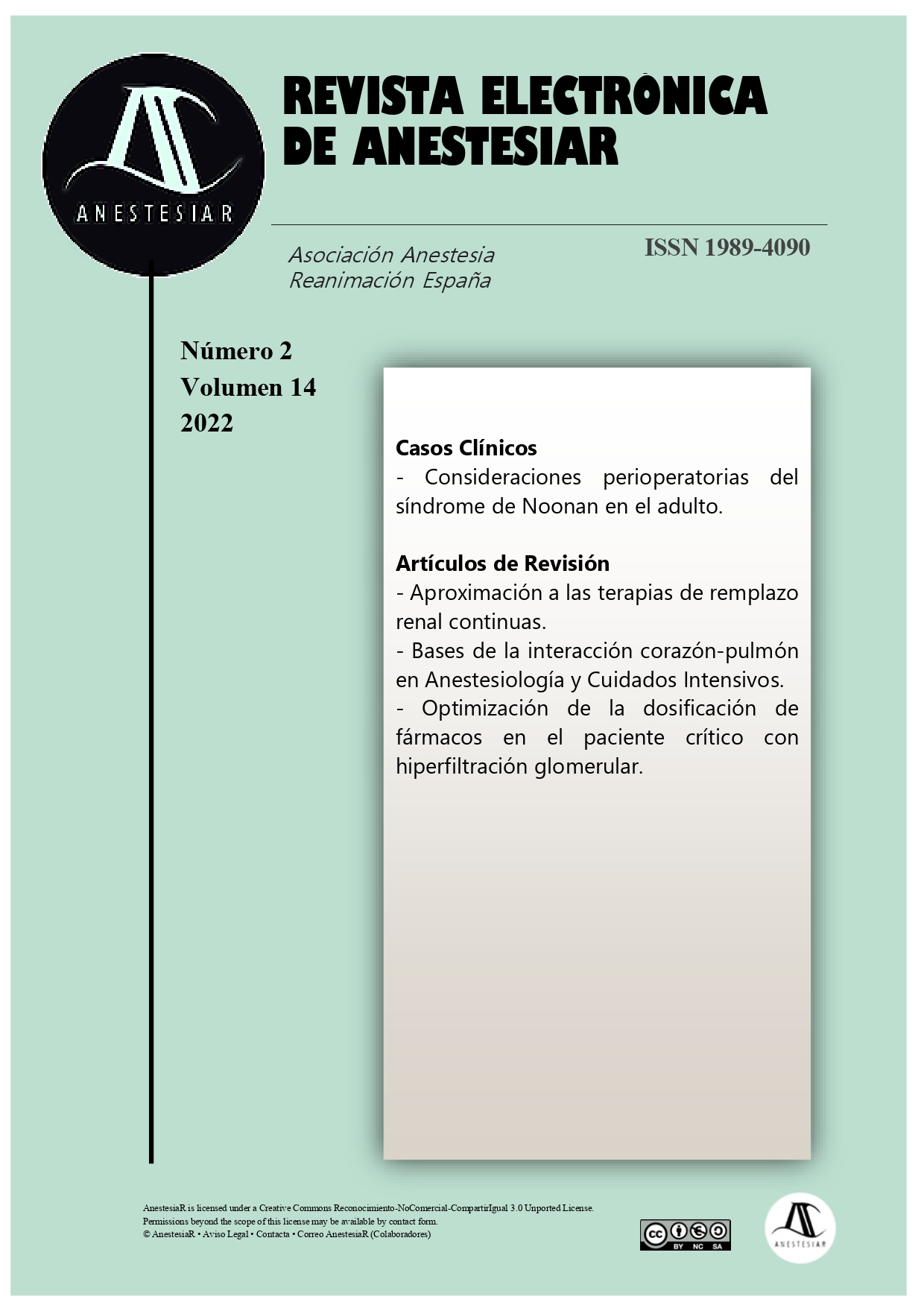Approach to continuous extrarenal replacement therapies in intensive care units (ICU).
DOI:
https://doi.org/10.30445/rear.v14i2.1009Keywords:
acute renal injury, dyalisis, sepsis, continue, Continuous renal replacement therapies, intensive care unitAbstract
Acute renal failure (ARF) is defined as an abrupt decrease in kidney function and is a very common entity in intensive care units (ICU). Its etiology is multifactorial and it is estimated that around 5-10% of patients who develop ARF in the ICU will require renal replacement therapy.
The objective of this bibliographic review is to make an approximation to the knowledge that an anesthesiologist should have on the management of renal replacement therapies. For the preparation of this review, a non-systematic bibliographic search was carried out in the Pubmed and Cochrane databases and included meta-analyzes, reviews, and clinical practice guidelines published in the last 10 years.
References
Susantitaphong P, Cruz DN, Cerda J, et al. World incidence of AKI: a meta-analysis. Clin J Am Soc Nephrol 2013;8(9):1482–93).
Kidney Disease: Improving Global Outcomes (KDIGO) Acute Kidney Injury Work- group. KDIGO clinical practice guideline for acute kidney injury. Kidney Int 2012; 2:1–138.
Michael Heung, Lenar Yessayan. Renal Replacement Therapy in Acute Kidney Injury: Controversies and Consensus. Crit Care Clin 33 (2017) 365–378.
SS.M. Galvagno Jr. et al. Practical considerations for the dosing and adjustment of continuous renal replacement therapy in the intensive care unit. Journal of Critical Care 2013.
R. L. Mehta, “Renal-replacement therapy in the critically ill - does timing matter?,” New England Journal of Medicine, vol. 375, no. 2, pp. 175-176, 2016).
A. Zarbock, J. A. Kellum, C. Schmidt et al., “Effect of early vs delayed initiation of renal replacement therapy on mortality in critically ill patients with acute kidney injury,” Jama, vol. 315, no. 20, pp. 2190–2199, 2016.
S. Gaudry, D. Hajage, F. Schortgen et al., “Initiation strategies for renal-replacement therapy in the intensive care unit,” New England Journal of Medicine, vol. 375, no. 2, pp. 122–133, 2016.
Fayad AII, Buamscha DG, Ciapponi A. Timing of renal replacement therapy initiation for acute kidney injury. Cochrane Kidney and Transplant Group, editor. Cochrane Da-tabase of Systematic Reviews [Internet]. 2018 Dec 18.
The STARRT-AKI Investigators. Timing of Initiation of Renal-Replacement Therapy in Acute Kidney Injury. N Engl J Med. 2020 Jul 16;383(3):240–51.
Chávez-Iñiguez JS, Cerdá J. Principios y modalidades en terapia de reemplazo renal continua. GMM. 2019 Jan 29;154(91):799.
McCunn M, Reynolds H, Reuter J, McQuillan K, McCourt T, Stein D. Continuous renal replacement therapy in patients following traumatic injury. Int J Artif Organs 2006;29:166–86.
Alvarez G, Chrusch C, Hulme T, Posadas-Calleja JG. Renal replacement therapy: a practical update. Can J Anesth/J Can Anesth. 2019 May;66(5):593–604.
Ronco, Ricci, De Backer, Kellum, Taccone, Joannidis et all. Renal replacement ther-apy in acute kidney injury: controversy and consensus. Crit Care. 2015; 19(1): 146
Schefold, Haehling, Pschowski, Bender, Berkmann et all. The effect of continuous versus intermittent renal replacement therapy on the outcome of critically ill patients with acute renal failure (CONVINT): a prospective randomized controlled trial. Crit Care 2014 Jan 10;18(1):R11. doi: 10.1186/cc13188.
Arif Khwaja. KDIGO Clinical Practice Guidelines for Acute Kidney Injury. Nephron Clin Pract 2012;120:c179–c184.
Ahmed AR, Obilana A, Lappin D. Renal Replacement Therapy in the Critical Care Setting. Critical Care Research and Practice. 2019 Jul 16;2019:1–11.
Fayad AI, Buamscha DG, Ciapponi A. Intensity of continuous renal replacement therapy for acute kidney injury. Cochrane Kidney and Transplant Group, editor. Cochrane Database of Systematic Reviews [Internet]. 2016 Oct 4.
Ying Wang, Martin Gallagher et al. Renal replacement therapy intensity for acute kidney injury and recovery to dialysis independence: a systematic review and individual patient data meta-analysis. Nephrol Dial Transplant (2017) 1–8.
Karkar A, Ronco C. Prescription of CRRT: a pathway to optimize therapy. Ann In-tesive Care. 2020 Dec;10(1):32.
Downloads
Published
How to Cite
Issue
Section
License
Copyright (c) 2022 Revista Electrónica AnestesiaR

This work is licensed under a Creative Commons Attribution-ShareAlike 4.0 International License.
 Envío y derechos de autor
Envío y derechos de autor


 Revista Electrónica AnestesiaR by
Revista Electrónica AnestesiaR by 